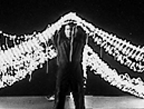|
An Object Orientation: A Theatrical Reexamination of the Man-and-Machine Struggle in the Information Age
In the summer of 1994, San Francisco-based Modus Ensemble presented the premiere of the play An Object Orientation. The play is a fable about man's search for meaning in a world influenced by technology and defined by information [1]. As artistic director of Modus Ensemble, I wrote and directed the play, which was created for a theater-going public curious about the ever-increasing impact of technology on our culture and continues the artistic man-and-machine exploration that began earlier in this century. Modus Ensemble, whose mission is to push the boundaries of theater, dance and music by exploring humanistic concerns in today's evolving information age, presented this technologically influenced drama by using the most powerful medium -- human beings. No computers or special monitors were used on stage. An Object Orientation is the story of two Waiting For Godot--like characters, If and Loop, who come from the older, structured software world of the past. These two have searched for a missing piece of data for so long that the search has become meaningless. They appeal to a group of software "objects" -- personified in the play as human characters -- for aid in their efforts to solve the mystery and update their quest. Agreeing to help, the objects start a search, briefly touching on aspects of history, life and popular culture. These six objects adopt the manner of Pirandello's Six Characters in Search of an Author by blurring the lines between reality and illusion, dynamically recasting themselves at will, changing the genre of the acting of each scene and employing reusable modules of text, movement or staging throughout the play. In the end, after the objects have done their playful yet exhaustive searches, an important discovery is made. Through this revelation, the play dramatizes the core issue facing "content" today -- essentially whether our culture's current obsession with information obscures our greater need for meaning. In the 1920s, movements such as Russian Constructivism and the Bauhaus emerged as a response to the changing conditions brought on by the rise of the Industrial Age. In performances, directors such as Vsevold Meyerhold used mathematical formulas as the basis for the machine-like movements of actors used to depict industry in the theater and, in the broader sense, in life itself. In the case of An Object Orientation, the relationship of man and machine is still being explored. At the dawn of the Information Age, today's industry is computers and, more specifically, the software that runs on computers. An Object Orientation is a play that uses an "object-oriented" software-programming language as its structural base to define a new performance aesthetic for the man-and- machine relationship in the information age. Object-oriented technology is a revolutionary software methodology that utilizes "reusable" modules to make software more interchangeable and better able to simulate real-world events, places and things. The actors playing objects in the play continually recast themselves in new roles -- becoming in a way, reusable characters, modifying their behavior according to changes dictated by the various scenes and interactions (Fig. 4). The correlation between the human metaphors and the hidden technological concepts (polymorphism, inheritance, classes, etc.) in the play demonstrates how new software environments more closely mimic the way people interact and shows the need for maintaining a humanistic approach in our technology-driven world. In fact, as its central theme, the play uses the computer search as a metaphor for the human search for meaning and blurs the boundaries between the two.
Note1. An Object Orientation was supported by the Object Management Group (OMG), a non-profit consortium of over 400 computer companies from all over the world; Stanford University; and One Abstract, Inc., a San Francisco based creative/strategic consulting firm. The Stanford University Department of Drama hosted in 1993 a workshop production of the play in which group discussions after each performance with members of the general public and representatives of Silicon Valley computer companies provided important feedback about the ideas in the script. Carl Weber, a former associate of Bertolt Brecht and a Stanford drama faculty member, was the literary advisor for the play. |
___________________________________________________________________________________________________
©1995 ISAST
